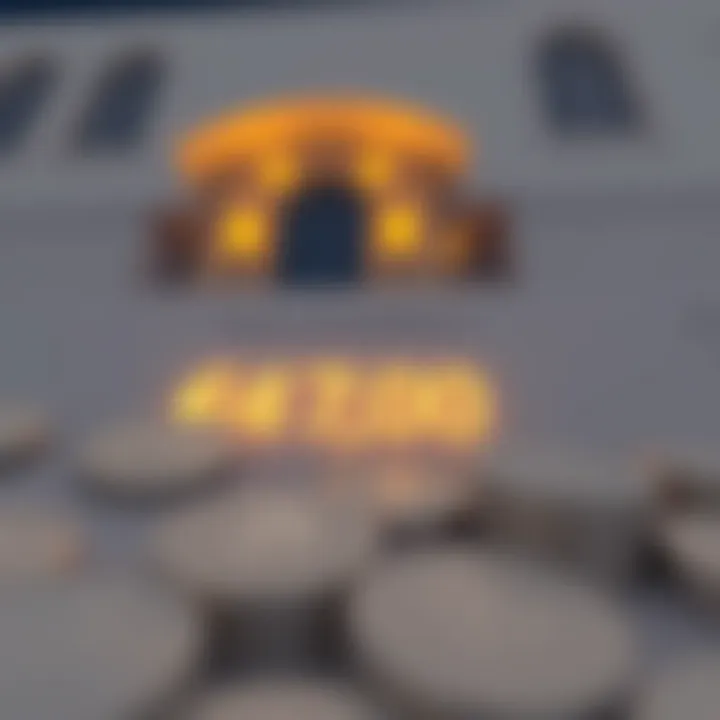Understanding Currency Conversion: 400,000 USD to AED


Intro
In today's interconnected financial landscape, navigating the waters of currency conversion is vital for both investors and expatriates alike. When dealing with substantial sums, such as 400,000 USD, understanding the conversion process into AED becomes not just a matter of numbers, but a strategic necessity.
Here we will unpack the significance of current exchange rates, which can fluctuate due to various market forces. We'll delve into what influences these rates, particularly in the context of real estate transactions in a dynamic market like Dubai, where the stakes are high and opportunities abound. This exploration offers insights crucial for making informed investment decisions in this vibrant city.
By the end of this article, you'll have a clearer picture of how to efficiently approach the conversion process, while gaining an understanding of the broader economic factors that impact currency values both locally and globally.
Prelims to Currency Conversion
Currency conversion is a pivotal aspect of global financial transactions, particularly for individuals and businesses engaged in cross-border trades or investments. When it comes to converting a substantial amount like 400,000 USD into AED, understanding the nuances of currency values becomes not just beneficial but essential.
For investors looking at the real estate market in Dubai, currency conversion can make or break a deal. The fluctuation of exchange rates can lead to significant financial shifts, impacting the purchasing power of foreign buyers. Thus, having a grasp on how these processes work allows these stakeholders to make informed decisions, aligning their financial strategies with current market trends.
Importance of Currency in Real Estate Transactions
In the realm of real estate, currency plays a crucial role. When international buyers enter the Dubai property market, the currency used for transactions – whether it's the USD or AED – dictates not only the price of properties but also the overall investment landscape.
- Liquidity: Transactions need a swift conversion process to ensure liquidity. Investors must be aware of the conversion timelines, as delays can affect negotiation outcomes.
- Price Negotiations: Currency fluctuations become a talking point in negotiations. For instance, if the USD strengthens against the AED, it may provide heavier purchasing power, influencing pricing strategies.
- Market Stability: Understanding currency trends offers insights into market stability. A stable currency exchange reflects a stronger economy, attracting investors.
Additionally, local regulations on foreign investments can change, which may affect currency and pricing. Therefore, keeping an eye on how currency interacts with the local real estate market gives investors a competitive edge.
Understanding Exchange Rates
The exchange rate between the USD and AED comes into play significantly when converting currencies. Essentially, it refers to the value of one currency in relation to another.
- Factors Influencing Exchange Rates:
- Market Sentiment: This can be an elusive factor. Investor perceptions, political stability, and economic forecasts can sway exchange rates considerably.
- Interest Rates: Central banks influence currency valuations through monetary policy. For example, a rise in interest rates in the U.S. might strengthen the USD against the AED as foreign investments increase.
- Inflation Rates: The balance of inflation rates between two countries affects purchasing power, which in turn impacts currency valuation.
Understanding these dynamics is key for any investor looking to navigate the waters of currency conversion and ultimately succeed in their transactions. It’s a matter of timing and strategic insight that can determine whether you're getting your money's worth when moving funds across borders.
Current Exchange Rate Analysis for USD to AED
Understanding the current exchange rate between the US dollar and the UAE dirham is a vital aspect for anyone engaged in international finance, particularly in real estate. The exchange rate is not merely a number; it's a reflection of various economic conditions, political situations, and market sentiments.
It acts as an indicator of how much the UAE dirham is worth compared to the US dollar. When converting a significant sum, like 400,000 USD, small fluctuations in the exchange rate can mean considerable gains or losses. Hence, deep analysis is indispensable for making informed decisions. When the USD strengthens, conversions to AED yield higher amounts; conversely, a weaker dollar diminishes potential returns.
Analyzing the current exchange rate allows individuals to strategically time their currency conversions and optimize their investments.
Recent Trends and Fluctuations


In the past year, the USD to AED exchange rate has displayed some interesting patterns. Generally, the AED is pegged to the USD at a rate of approximately 3.67 AED to 1 USD. However, fluctuations can still occur within this framework due to various influences.
- Economic Indicators: Economic data such as unemployment rates, inflation figures, and GDP growth in the US can lead to shifts in investor confidence in the dollar, thereby impacting the exchange rate. For instance, higher interest rates in the US typically draw more foreign investment, strengthening the dollar and its purchasing power abroad.
- Global Events: International events, such as geopolitical tensions or natural disasters, can also cause volatility. When such events occur, investors often flock to what they consider safe havens, which can include the US dollar.
- Speculative Trading: Traders in Forex markets often react to news and other signals, creating a feedback loop that can exacerbate fluctuations. In the case of USD to AED, any shifts in investor sentiment toward US economic prospects affect this currency pair.
Taking into account these trends is crucial for any investor looking to convert large amounts of currency. Monitoring news feeds, financial reports, and expert analyses can help anticipate shifts in the exchange rate.
Long-term Historical Data
Looking back at the longer-term trend of the USD to AED exchange rate presents illuminating insights. Over the last decade, while the AED has remained pegged to the dollar, other economic factors have led to price fluctuations that are worth noting.
- Stability of the AED: The fixed exchange rate policy fosters a sense of stability, making the UAE an attractive destination for foreign investments. This has solidified the dirham’s reputation as a stable currency in a volatile region.
- Comparative Analysis: When looking at the historical performance, the AED’s stability in relation to currencies like the euro or yen can showcase its strength. This stability can play a key role in influencing investor decisions, especially in long-term planning.
- Burgeoning Real Estate Sector: The growth of Dubai’s real estate market also serves as a backdrop for understanding currency movements. As more foreign investors flocked into the sector, demand for AED increased, impacting currency supply and inflation metrics.
Calculating , USD to AED
When venturing into the realm of currency conversion, particularly for significant sums like 400,000 USD, it’s essential to grasp the mechanics involved in the calculation process. Currency conversion is not just a simple numerical change; it encapsulates financial strategies, investor sentiment, and the broader market trends all at play. For investors and expatriates looking to engage in Dubai’s real estate market, understanding how to accurately convert currencies can be the difference between a lucrative investment and a lost opportunity.
Step-by-step Conversion Process
Calculating the conversion from USD to AED involves a few straightforward but critical steps:
- Check the Current Exchange Rate: Begin by determining the exchange rate for USD to AED. Websites like XE.com or OANDA provide up-to-the-minute information that can ensure accuracy.
- Multiply the Amount in USD by the Exchange Rate: Use the formula:Suppose the current exchange rate stands at 3.65. The math would look something like this:Thus, at an exchange rate of 3.65, 400,000 USD equals 1,460,000 AED.
- Account for Additional Fees: Don’t overlook banks and money exchange services that might impose charges for the conversion. This may vary significantly from one provider to another, and it’s wise to factor these into your final total.
- Recheck the Exchange Rates Periodically: Since exchange rates fluctuate, checking them multiple times a day can help you secure the best deal.
By following these steps, investors can streamline the conversion process for significant investments, gaining confidence in their decisions.
Tools and Resources for Conversion
In the digital age, a plethora of tools and resources exist to aid in currency conversion. These assist not only with calculations but can also inform users about the larger financial landscape. Here are some noteworthy examples:
- Currency Conversion Websites: As mentioned earlier, sites like XE.com, OANDA, and Forex can provide real-time exchange rates and tools for quick calculations.
- Finance Apps: Many mobile apps cater to currency conversion, including Wise and Revolut. These apps also often provide insights based on historical data and forecasts.
- Financial News Websites: Websites like Bloomberg and CNBC offer insights into market trends that impact currency values. Keeping up with these resources can guide users on when to make currency conversions.
- Banking Apps: Major banks such as JPMorgan or HSBC often feature currency conversion tools right within their mobile banking applications, allowing easy access for customers.
- Social Media and Forums: Platforms like Reddit can provide anecdotal advice from users who’ve gone through similar conversions. Engaging with a community can unveil tips or resources that may not be readily apparent.
Each tool has its unique benefits, making them invaluable for anyone looking to dive deep into the nuances of currency conversion and investment decisions.
Knowing where to find accurate rates and resources can save both time and money when handling significant currency exchanges.
Understanding these elements leads not only to a successful conversion but also empowers individuals to make informed decisions in their financial endeavors.
Factors Influencing Exchange Rates
Currency conversion, particularly the conversion of USD to AED, doesn’t operate in a vacuum. Understanding the factors that influence exchange rates is crucial for investors, homebuyers, and expatriates alike. Exchange rates are determined by a complex interplay of various elements that can fluctuate predictably or unpredictably. This knowledge isn't just academic; it directly impacts how much AED one gets for USD and influences the broader real estate market in Dubai.
A well-rounded approach to currency conversion should account for economic indicators, political stability in the UAE, and market sentiment. These factors shape not only the immediate exchange rate but also the long-term trends, making them indispensable for anyone planning significant investments or transactions in the region.
Economic Indicators


Economic indicators are statistical metrics that provide insight into a country’s economic health. They can influence exchange rates by affecting investor perception and confidence. Here are a few key indicators to consider when analyzing the USD to AED conversion:
- Inflation Rates: Higher inflation rates in the U.S. can erode purchasing power, making USD weaker against AED.
- Interest Rates: If the Federal Reserve raises interest rates, it often strengthens the dollar as investors seek higher returns associated with USD-denominated assets.
- Gross Domestic Product (GDP) Growth: Strong GDP signals a robust economy, which typically strengthens the currency.
For instance, if the U.S. reports strong GDP growth, investors may flock to the dollar, driving up its value and thereby making conversions to AED more beneficial for those exchanging larger sums like 400,000 USD.
Political Stability and Economic Policies
A country’s political environment plays a significant role in its currency stability. In the case of the UAE, political stability generally enhances investor confidence. When potential investors feel assured that economic policies are favorable, they are more likely to invest, thus increasing demand for AED and affecting its exchange rate against USD.
Considerations:
- Regulatory Environment: A clear and favorable regulatory environment attracts foreign investment, propelling demand for AED.
- Diplomatic Relations: Strong international relations can bolster a country’s economic standing, positively affecting its currency.
If there were any shifts in these factors, it could have consequences for exchange rates. For instance, if the UAE were to implement policies that favor foreign investment, it could drive up the value of AED against other currencies, including the USD.
Market Sentiment and Predictability
Lastly, market sentiment plays an intangible yet pivotal role in shaping currency values. This sentiment encompasses how investors feel about the economic outlook and political climate in both the U.S. and the UAE. When market sentiment is positive towards a particular currency, investors react accordingly.
- Expectations and Predictions: Traders often make decisions based on anticipated future movements in exchange rates, creating a self-fulfilling prophecy.
- Media Influence: News reports and social media can shift market sentiment almost overnight. For example, a favorable report on UAE’s economic policies can strengthen AED.
In summary, the exchange rate from USD to AED is affected by a combination of economic data, political stability, and market behavior. An understanding of these factors can provide a clearer picture for anyone looking to convert a substantial amount of currency and navigate the complexities of the Dubai real estate market.
Implications for Real Estate Investors in Dubai
For investors eyeing the Dubai real estate market, understanding the nuances of currency conversion from USD to AED is not merely a footnote; it is essential to their overall investment strategy. With Dubai being a prime destination for expatriates and investors alike, knowing how to navigate the currency landscape can make the difference between a profitable venture and a costly misstep.
The implications of this currency conversion extend beyond mere numbers. They touch on fundamental elements like market entry strategy, financial risk management, and potential returns on investment. Currency fluctuations can have significant ripple effects on property prices, making it crucial for investors to keep a keen eye on the current exchange rates.
Investment Opportunities in Dubai
Dubai's property market presents a plethora of investment opportunities, particularly in high-demand sectors such as residential, commercial, and retail properties. The emirate's strategic location, coupled with its robust infrastructure and attractive lifestyle, fosters a vibrant real estate environment. Furthermore, upcoming events like Expo 2020 are set to boost the market's attractiveness significantly.
"Dubai is not just a city; it's a land of opportunities, especially in real estate. Investors need to seize the moment as currency dynamics can either bolster or hinder their purchasing power."
When converting 400,000 USD to AED, investors need to consider how the amount aligns with market trends. For instance, while the current exchange rate might offer a favorable conversion, long-term forecasts could suggest waiting might be better. Fluctuations can create opportunities to buy low during dips, allowing savvy investors to maximize their capital.
Investors must also consider the type of property they wish to invest in. Areas such as Dubai Marina, Downtown Dubai, and Jumeirah Beach Residence (JBR) are hot commodities, often experiencing rapid appreciation. Meanwhile, emerging areas might offer lower entry prices with significant upside potential. A thorough market analysis provides insights into these prospects and informs the decision-making process.
Foreign Buyers and Legal Considerations
Navigating foreign investment in Dubai requires a clear grasp of legal frameworks and property ownership laws. The UAE encourages foreign ownership, allowing up to 100% ownership in designated freehold areas. However, prospective investors should familiarize themselves with the local laws governing property transactions, which can be quite different from their home countries.


Additionally, understanding the legal implications of currency exchange is vital. Fees associated with conversion, such as transaction costs at banks or money exchanges, can chip away at the overall investment budget. Furthermore, ensuring compliance with local regulations protects against potential legal issues that could arise during or after the purchase process.
Investors should seek to have a legal advisor or a trusted agent familiar with Dubai's real estate regulations to streamline the buying process. From understanding title deeds to navigating future tax obligations, expert guidance is crucial.
In summary, the implications of currency conversion for real estate investors in Dubai cannot be understated. By being well-informed about both the financial and legal aspects, investors can position themselves for success in a lucrative market.
Managing Currency Risks
In the world of finance, managing currency risks is crucial, especially for investors and expatriates dealing with cross-border transactions. When dealing with significant amounts like 400,000 USD, understanding the risks associated with currency conversion becomes a key component of sound financial planning. Fluctuations in exchange rates can considerably impact the value of investments, profits from real estate, or when purchasing goods and services abroad.
Hedging Techniques for Investors
Investors can employ several hedging techniques to counteract potential losses due to unfavorable currency movements. One effective method is forward contracts. These agreements lock in the exchange rate for a future date, shielding investors from sudden shifts. If an investor knows they will need AED at some point, they can use a forward contract to set the rate today, ensuring that they don’t face adverse rate changes later.
Another popular strategy is options trading. Options provide the investor with the right, but not the obligation, to exchange currency at a predetermined rate. This flexibility can be advantageous, especially when market conditions are unpredictable. That way, if rates move in their favor, they can execute the option and save money.
Additionally, currency ETFs (Exchange-Traded Funds) can be used to gain indirect exposure to currency movements without the complexities of direct currency trading. With these financial instruments, an investor can invest in a diversified portfolio that tracks a specific currency or group of currencies, providing a buffer against localized currency volatility.
In summary, employing these hedging techniques can help mitigate risks and protect investments in a volatile landscape.
Choosing the Right Time for Conversion
Timing the currency conversion process is also essential for investors looking to maximize their returns. Fluctuations in the exchange rate can occur for various reasons, including market sentiment, economic indicators, and geopolitical events. For instance, if economic reports suggest that the U.S. economy is strengthening, the USD may appreciate against the AED. In such cases, delaying conversion until a more favorable rate could yield significant savings.
Investors should keep a keen eye on market trends and be proactive in their approach. Setting up alerts through financial websites or applications can provide timely updates about significant changes in exchange rates.
It’s also valuable to learn about historical patterns. Understanding seasonal trends or cyclical behavior in currency rates can offer clues about when to convert. While no one can accurately predict the market, a well-informed approach can lead to better decision-making.
As a general rule, patience and knowledge can be your best tools in navigating the often turbulent waters of currency exchange. By choosing the right time for conversion, you can capitalize on favorable conditions, ultimately enhancing your overall investment strategy.
Closure
As we wrap up our exploration of converting 400,000 USD to AED, it becomes clear that understanding currency conversion is crucial in today’s global economy, especially for individuals engaging in real estate in cities like Dubai. The process goes beyond mere math; it involves a nuanced grasp of market forces, economic conditions, and political implications.
Summarizing Key Insights
Throughout this article, we've examined the various elements at play in currency conversion. Here are some key takeaways:
- Current Exchange Rates: The USD to AED exchange rate fluctuates based on numerous factors such as supply and demand, geopolitical developments, and economic indicators. Being aware of these dynamics allows investors to make informed decisions.
- Factors Influencing Rates: Economic indicators like GDP growth rates, unemployment statistics, and inflation can provide insights into currency strength. Political stability also plays a significant role. A country with stable governance is more likely to see a stronger currency.
- Investment Implications: For foreigners entering the Dubai real estate market, understanding the currency conversion process not only aids in proper budgeting but also influences the timing of property purchases.
- Risk Management: Introducing hedging techniques can help mitigate potential currency-related risks, making investments more secure. Choosing the right time for conversion can lead to significant financial gains.
All these insights underline the importance of having a solid grasp on both the mechanics of currency conversion and the broader economic context. This knowledge empowers investors to make strategic decisions rather than rushed, reactive ones.
Future Outlook for USD to AED Exchange
Looking ahead, the future of the USD to AED exchange rate hinges on a cocktail of factors, both local and international. As economies recover or shift in response to global trends, exchange rates are unlikely to remain stagnant. Key aspects to consider include:
- US Economic Policies: The actions taken by the Federal Reserve, including interest rate decisions, can heavily impact USD strength against the AED. Investors should stay abreast of these developments to anticipate currency movements.
- Geopolitical Tensions: Any disruptions in geopolitics will produce ripples throughout currency markets. Regional stability in the Gulf area can prove advantageous to the AED's valuation.
- Emerging Market Adaptations: The growing presence of digital currencies and evolving financial technologies may alter standard currency conversion processes, introducing new dynamics.
This evolving landscape invites investors to adapt continually. By keeping a keen eye on these factors, one can capitalize on favorable conditions or hedge against unfavorable shifts in the USD to AED exchange rate. Ultimately, awareness, preparedness, and agility in response to market indicators will determine success in navigating the complexities of currency conversion.



